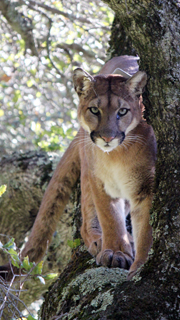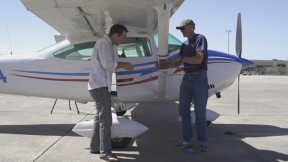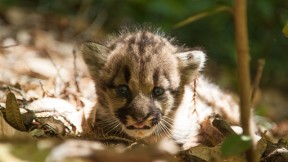Call them pumas, mountain lions, cougars, panthers, or any other of their various monikers; the sight of one of these full-grown cats staring down at you from a nearby tree is undeniably exhilarating. As ambush predators, pumas are professional hiders, and even regular visitors to puma habitat will likely go their entire lives without ever catching sight of North America’s largest cat.

On a beautiful summer day, we had the opportunity to follow Field Biologist Paul Houghtaling of the Santa Cruz Puma Project (SCPP) as he searched the rough back roads of the CEMEX Redwoods Property in Davenport, CA. Lead by Chris Wilmers, an Associate Professor of Environmental Studies at University of California Santa Cruz, the team has gained renown for their work tracking the big cats in the Santa Cruz Mountains, as well as some high profile captures of pumas that ventured too close to human habitations.
As an apex predator in our Northern California region, mountain lions have huge home ranges. While mother pumas will remain in one area to raise their kittens, pumas generally patrol their territories without making use of any den or other home base. Paul informed us that female mountain lions tend to set their ranges depending on prey availability, which in the Santa Cruz Mountains tends to be deer. Adult males create their home ranges to include female mountain lions and exclude other males. The remaining young male pumas are forced to disperse and seek new territories, and it is often these individuals that get into trouble with humans.

As we made our way through the redwoods, Paul occasionally slowed and peered out through the side window of the truck, surveying the dust that accumulates in the inside of the curves of the dirt roads. Traveling pumas rarely obey traffic rules, and tend to cut corners when walking along roads. Paul searched there for footprints and other telltale mountain lion signs.
The team employs several other techniques to determine if lions are in the area. This includes laying out road-killed deer with GPS tags in areas thought to be big cat territory. If a hungry lion moves the deer, the GPS tag sends an email to the team, who then head out to investigate.
Once pumas reach adulthood, they live solitary lives, but still need to communicate with each other. One of the main ways they do so is by making ‘scrapes.’ Pumas, particularly adult males, will dig small holes and then urinate on the pile of loose soil created by the digging. Other pumas that frequent the area can interpret the chemical signal to gather information about the cat’s identity and reproductive status based on the signature proteins left behind. Pumas tend to make scrapes in the same areas over time, making it easier for other pumas (and intrepid field biologists) to find learn about which lions are in the area. The research team sets up camera traps in these areas in order to document which cats are have taken up residence in the area.
